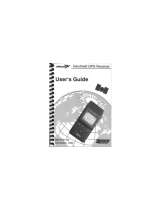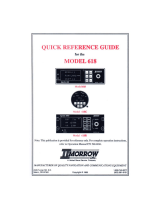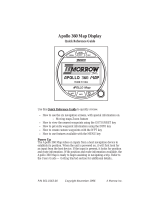Page is loading ...

Apollo
SL50 and SL60
GPS Receiver and
VHF Communications
Transceiver
User’s Guide
560-0955-00 March 1997

No part of this document may be reproduced in any
form or by any means without the express written
consent of II Morrow Inc.
II Morrow and Apollo are trademarks of II Morrow Inc.
© 1997 by II Morrow Inc. All rights reserved.
Printed in the U.S.A.
II Morrow Inc.
Consumer Products Division
2345 Turner Road, S.E.
Salem, OR 97302
U.S.A. Toll Free 800.525.6726
Canada Toll Free 800.654.3415
International 503.391.3411
FAX 503.364.2138
Visit our web page at http://www.iimorrow.com
Send comments about this manual by email to:
II MORROW
VISIONARY THINKING TODAY

Welcome ...
Welcome to a new era of aviation navigation
communication. Once again, II Morrow Inc. has set
new standards in features and ease of use for the
general aviation public. The Apollo SL50 and SL60
are unequaled in providing the features, level of
performance, and reliability that aviation users
require. The Apollo slim line series of avionics sets
a precedent that will be the standard that all other
avionics will be compared to. The Apollo SL50 is a
full-featured slim line GPS receiver. The Apollo
SL60 combines the capabilities of our outstanding
GPS receiver with a state-of-the-art VHF
communications transceiver in the same small
package. You can be confident in knowing that you
are the owner of the state-of-the-art in aviation
navigation and communication. Our products are
built to last and to satisfy your navigation needs.

History of Revisions
March 1997 Original Release
April 1997 Rev -01
Ordering Information
To receive additional copies of the Apollo SL50/60
manuals order the following part numbers:
User’s Guide 560-0955-xx
User’s Guide Binder (3/4”) 560-9002-xx
Installation Manual 560-0957-xx
SL50 Quick Reference 561-0235-xx
SL60 Quick Reference 561-0239-xx
Important Notice

TABLE OF CONTENTS
Welcome ... ······································i
History of Revisions ······························ii
Ordering Information·····························ii
Introduction·····································1
SL50·····································1
SL60·····································2
Display···································2
Annun-
ciators····································3
Relative Bearing Indicator·················3
Controls··································4
Power Knob (SL50)······················4
Small and Large Knobs···················4
Keys ·····································4
Flip/Flop (Arrows) - SL60 ················4
NRST (Nearest Waypoint) - SL50 ··········4
COM (Communications Radio Mode) - SL60 · 4
WPT (Waypoint) - SL50··················5
NAV (Navigation)·······················5
SYS (System Mode) ·····················5
MSG (Message)·························5
DIRECT-TO ···························5
INFO (Information)······················5

SEL (Select) ···························5
ENT (Enter)····························5
Apollo SL50/60 Features ·······················6
Getting Started the First Time ··················9
Power Up ·································9
Seed Position ······························9
Entering a Seed Position ····················10
Change Reference Waypoint··············10
Change Lat/Lon Reference Position ········11
Checking GPS Signal Strength ···············13
Entering a Destination Waypoint··············14
Using the Nearest Waypoint Function ······14
·····································14
Using the Direct-To Function ·············15
Navigation Basics ····························17
About the Navigation Function ···············17
About the Navigation Function Displays········17
Nav Home Page ···························17
Autonav ·································18
Nav Pages································19
Nav Display Choices····················19
Emergency Search ·························25
Starting Emergency Search ···············25
Searching Around a Reference Waypoint····26

Setting Runway Limits ··················27
Special Use Airspace ·······················28
Parallel Track Offset ·······················29
GPS Position ·····························30
Countdown Timer ·························30
From/To/-
Next Waypoint····························32
Creating From/To/Next Waypoints·········32
Placing the To Waypoint on Hold··········35
Using Direct-To ···························36
Direct-To OBS····························36
Waypoint Functions ·····························37
Waypoint Information ······················37
Available Waypoint Information··············37
ARPT Waypoint Information ·············37
Getting Information about a Waypoint ·········39
Database Update ··························40
Nearest (Emergency Search) Waypoint ·········41
Starting Emergency Search ···············41
Create User Waypoint by Lat/Lon·············42
Create User Waypoint by Radial/-
Distance ·································44
Delete User Waypoint ······················45
Modify User Waypoint ·····················46

Waypoint Comments ·······················46
Flight Plan Functions·························47
Flight Plan Pages ··························47
Reaching the Flight Plan Function ·········47
Active Flight Plan ······················48
Creating a Flight Plan ······················48
Flight Plan Leg Information··················50
ETA·································51
ETA? ································51
LegETE ·····························51
Leg ETE?·····························51
ETE·································51
ETE? ································52
Fuel? ································52
Direct-To ·····························53
Manual Leg Activation ·····················53
Flight Plan Editing·························53
Changing Existing Flight Plan Legs ········54
Inserting a New Waypoint················54
Deleting a Waypoint ····················55
Flight Plan Options ························56
Activate ······························56
Rev Activate ··························56
Reactivate ····························56

Rename ······························56
Copy Plan ····························57
Estimate Ground Speed··················57
Clear Waypoints ·······················57
Reverse Flight Plan ·····················57
Estimated Fuel Flow ····················57
Delete Plan ···························58
Hold·································58
Continue ·····························59
Destination Waypoint Information ············59
Flight Plan Comments ······················59
Copying the Active Flight Plan ···············60
System Functions································61
Flight Plans ······························61
Waypoint Database ························61
Com Radio Information (SL60 Only) ·······62
Software Version·······················63
RF Signal Strength ·····················63
Audio Noise Level······················63
Intercom Squelch Level Adjustment ········63
Sidetone Level Adjustment ···············64
Navigation Information ·····················65
Airspace Setup·························65
Airspace Buffers ·······················65

Airspace Selections ·····················66
Autonav Time ·························67
Navigation Mode Programmable Pages and
Autonav Pages·························67
Creating a New Custom Nav Page ·········69
Setting Units ··························71
Magnetic Variation ·····················71
Flight Timer Trigger ····················72
Direct-To Entry Options ·················73
CDI Scaling···························74
System Information ························75
Date and Time ·························75
Software Version·······················76
Fuel Measure Units ·····················77
Test Display···························77
Owner Information ·····················77
GPS Sensor ······························79
Satellite Search Status ···················80
GPS Date and Time Page ················80
GPS Normal Reset Page ·················80
Comm Radio Operation·······················81
Power On/Off·····························81
Volume··································81

Small and Large Knobs··················81
Selecting Frequencies ·······················81
Frequency Monitoring ······················82
Recalling a Frequency ······················83
TO, FROM, and INFO Frequency Database· · 83
Auto Stored Frequencies (Auto) ·········85
User Stored Frequencies ·················86
Weather Channels ······················87
Emergency Channel ····················87
Intercom Function ·························88
Introduction to GPS Navigation ···················89
GPS Overview ····························89
GPS System Accuracy······················90
Summary ································90
Start Up Displays ·······························91
Owner Message ···························91
Memory Tests ····························91
Software Memory Test ··················92
Non-Volatile RAM Tests ················93
User Database Memory Failure············93
Miscellaneous NVRAM Memory Failure····94
Database Test ·························94
Special Use Airspace Displays ···············95
Database Message ·························95

IFR Output Tests ··························95
Message Function ····························97
New Messages ····························98
Old Messages·····························98
Messages ································98
Special Use Airspace Messages ···········98
Soon·································98
·····································98
·····································98
Close ································99
Inside ································99
Empty To Waypoint: Cannot Compute Nav· · 99
GPS Communications Failure·············99
GPS Command Failure ··················99
GPS Self Test Failure ··················100
GPS Sensor Lat/Lon Failure ·············100
GPS RAIM Not Available···············100
GPS RAIM Position Error···············100
GPS HDOP Position Error ··············101
Arrival At the To Waypoint ·············101
Holding at the To Waypoint ·············101
To Waypoint Sequence ·················102
Auto OBS Crossing Holding Waypoint ····102

User Database Memory Loss ············102
Comm Radio Failure (SL60 only)·········102
Flight Plan Memory Loss ···············103
User Memory Failure ··················103
Database Expired······················103
Database Invalid ······················103
Manual Magnetic Variation··············104
Low Internal Battery Voltage ············104
High Battery Voltage···················104
Countdown Timer Expired ··············104
Flight Simulator ·······························105
About the Flight Simulator ·················105
Starting the Flight Simulation ···············106
Flight Simulator Operations·················107
Troubleshooting ·······························109
Contacting the Factory·····················109
Glossary of Navigation Terms ····················111

Introduction
This guide describes the operation of the Apollo
SL50 GPS Receiver and the Apollo SL60 GPS
Receiver and VHF Communication Transceiver.
SL50 The Apollo SL50 is a high performance GPS
receiver with a high intensity LED display packed
into a 1.3 inch high by 6.25 inch wide package that
conserves panel space. The SL50 uses the same
8-channel GPS engine that is used in II Morrow’s
high end TSO C129 terminal and enroute certified
products. The 32 character alphanumeric LED
display uses an automatic intensity control to keep
it easily readable in all conditions from direct
sunlight to the dark of night.
The Apollo SL50 has a wealth of easy to use
features that every pilot needs. The large waypoint
database has information about airports, VORs,
NDBs, intersections, and special use airspaces that
makes the Apollo SL50 an encyclopedia of
aviation. The database can be updated by
connecting the SL50 serial port to a computer with
II Morrow’s innovative Waypoint Manager
software. The database can also include 200 custom
Power
Photocell
Nearest
Waypoint
Navigation
Mode
Direct To
Message
Mode
System
Mode
GPS
OFF/ON
Ete SLE 00:22 Brg 082 74 nm
POLLO
A
SL50
SEL
INFO ENT
D
Information
Display
Large, Outer
Knob
Small, Inner
Knob
Waypoint
Mode
Info
Mode
Select
Enter
WPT SYSNAV MSGNRST
Message
Annunciator

waypoints created by the user. Ten flight plans can
be saved with up to twenty legs for setting up
custom tailored routes. The detailed Navigation
information displays are also customizable and can
be set to automatically scroll through the desired
information. The Emergency Search feature,
invented by II Morrow, when used with the
Direct-To feature makes it easy to quickly select an
airport as a new destination whether because of a
change in plans, or to react to an emergency.
SL60 The Apollo SL60 combines all of the features of the
SL50 with a state-of-the-art VHF communications
transceiver in the same compact package. The VHF
comm radio covers all 760 channels with 8+ watts
(10 W typical for most frequencies) without any
external cooling devices required. A built-in
intercom capability works either with or replaces an
audio panel. The features and packaging of the
SL60 keeps your power requirements and
installation costs low. You can easily switch
between active and standby frequencies, select a
weather channel, activate the emergency channel, or
choose from one of ten customized frequencies or
one of the last ten used.
Display
Power/Volume/Squelch
Photocell
Flip/Flop
Frequency
Navigation
Mode
Direct To
Message
Mode
System
Mode
TX
GPS/COMM
PULL SQUELCH
VOL
OFF
119.80 s121.50
POLLO
A
SL60
COM SYSNAV MSG
SEL
INFO ENT
D
BRG 210' 17.1nm
Active
Frequency
Large, Outer
Knob
Small, Inner
Knob
Transmit
Annunciator
Comm Xcvr
Mode
Info
Mode
Select
Enter
Standby
Frequency
NAV
Info
Message
Annunciator

The display is a 1-line by 32-character 5x7 dot
matrix alphanumeric display. A photocell is located
in the top left corner of the front panel display. The
photocell automatically controls the light intensity
of the display LEDs from low brightness at night to
high brightness during daylight operation.
Annun-
ciators
Several annunciators are used to help indicate the
operating modes of your SL60. The TX (Transmit)
annunciator is lighted whenever you are
transmitting. If the avionics bus drops below 9
VDC, the SL60 will not transmit. An LED will be
lighted above the WPT/COM, NAV, SYS, or MSG
keys when they are pressed. An “s” normally
appears to the left of the Standby frequency. An “I”
appears to the left of the Standby frequency when
the Intercom function is active. An “m” will appear
to the left of the Standby frequency when you are
using the Monitor function.
TX - Transmit (SL60)
s - Standby Frequency (SL60)
m - Monitor Mode (SL60)
I - Intercom (SL60)
Relative Bearing Indicator
The Relative Bearing Indicator indicates an
approximate bearing to a waypoint or airspace
relative to the aircraft’s current Track when your
current ground speed is more than 5 knots. The
following illustration describes the bearing range
for each arrow.
MNOPQR\T
23º to
67º
68º to
112º
113º
to
157º
158º
to
202º
203º
to
247º
248º
to
292º
293º
to
337º
338º
to
22º

Controls Power/Volume/Squelch Knob(SL60)
The knob on the left side of the SL60 controls power
on/off, volume, and squelch test. Rotate the knob
clockwise (CW) past the detent to turn the power on.
Continue rotating the knob to the right to increase
speaker and headphone amplifier volume level.
Rotate the knob to the left to reduce the volume
level. Pull the knob out to disable automatic squelch.
Power Knob (SL50)
The knob on the left side of the SL50 controls
power on/off. Rotate the knob clockwise (CW) past
the detent to turn the power on. Rotate the knob
fully counterclockwise to turn the power off.
Small and Large Knobs
The dual concentric knobs on the right side of the
front panel are used to select pages, edit characters
and values, or other options.
Keys Nine backlighted keys allow you access the
functions in your Apollo SL50/60.
Flip/Flop (Arrows) - SL60
Press the Flip/Flop key to switch between the
active (left-most) and standby (right-most)
frequency while in the Nav or Com functions. You
may use an optional external Flip/Flop key for the
same operation as the front panel control. Switching
between frequencies is disabled while you are
transmitting or editing in any function.
NRST (Nearest Waypoint) - SL50
The Nearest Waypoint (Emergency) mode displays
the closest waypoints to your position.
COM (Communications Radio Mode) - SL60
Press the COM key to operate the Communications
radio functions.
COM
NRST

WPT (Waypoint) - SL50
The Waypoint key allows access to the waypoint
database. (SL60 accesses the database from within
the System function - see page 39.)
NAV (Navigation)
Press the NAV key to reach the navigation
functions.
SYS (System Mode)
Press the SYS key to reach the System mode
functions. System mode is used to make system
level adjustments, setup flight plans, access the
database, and modify Nav function displays.
MSG (Message)
Press the MSG key to reach the Message functions.
The MSG annunciator will flash when a new
message is provided. In the SL60, pressing MSG
twice will start the Nearest Waypoint mode just as
pressing NRST will on the SL50.
DIRECT-TO
The DIRECT-TO key is used to define a direct
course from your present position to a waypoint.
INFO (Information)
The Info function accesses supplementary
information about a waypoint.
SEL (Select)
The SELECT key activates editing or the selection
of options. Editing is active on the items that flash
on the display.
In the SL60 when the COM function is active,
pressing the SEL key will recall stored frequencies.
ENT (Enter)
The ENT key enters and saves the information
flashing on the display. If the ENT key is not
pressed after editing, any changes made are not
saved.
In the SL60 when the COM function is active,
pressing the ENT key will save the standby
frequency into the Auto Stack list.
SEL
ENT
INFO
D
NAV
SYS
MSG
WPT

Apollo SL50/60 Features
SL50/60 GPS Navigation Features
SL50/60 GPS Receiver Performance Specifications

SL60 Comm Radio Features
SL60 Comm Radio Performance
Physical Specifications
Interfaces
/



